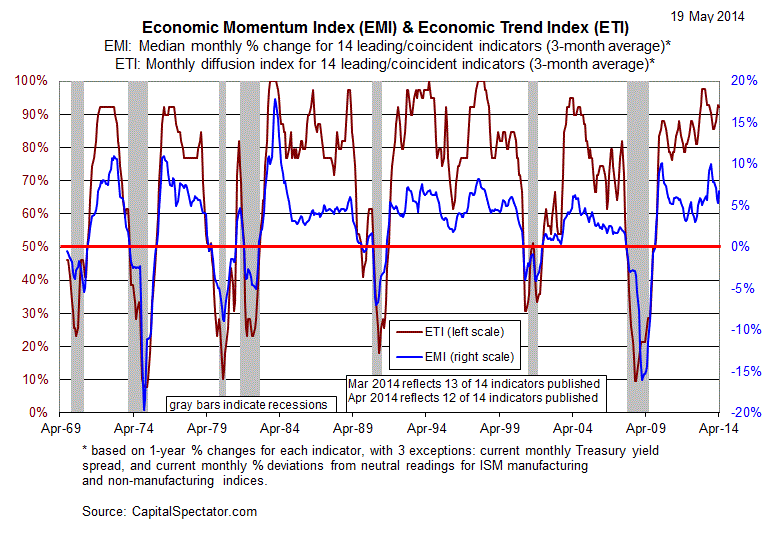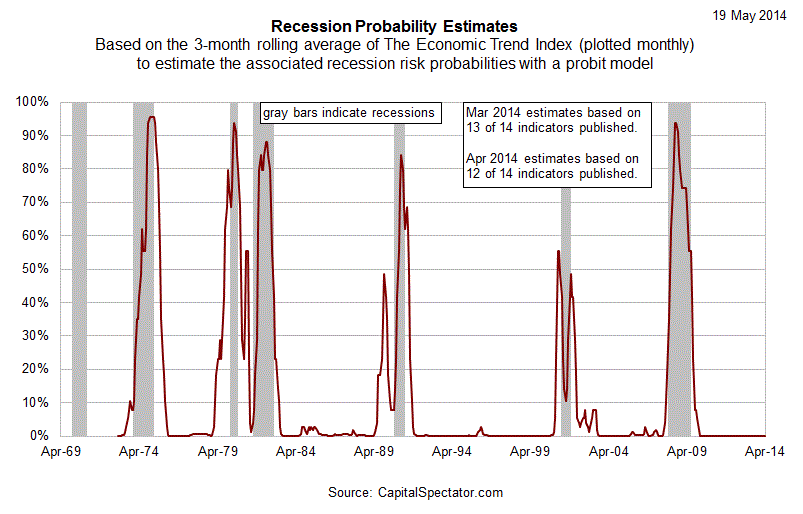Economic momentum remained broadly positive in April. It may not feel like growth, but the macro trend remains firmly skewed toward expansion, based on the latest profile of last month’s numbers. Indeed, the April update of a diversified set of 14 economic and financial data sets betray minimal signs of stress in the search for business cycle risk.
The quantitative source of this analysis is the fact that the Economic Trend and Momentum indices (ETI and EMI, respectively) remain at levels that equate with expansion. The near-term projections imply that the upbeat trend will roll on. Although the first-quarter GDP data tells us that the US economy stalled in the first three months of this year, ETI and EMI suggest that the forward momentum is considerably stronger than the government’s quarterly data suggest.
A broad review of economic and financial trends show that recession risk is still low. Using a methodology outlined in Nowcasting The Business Cycle: A Practical Guide For Spotting Business Cycle Peaks, the indicators listed below collectively paint an upbeat profile at the moment.
A pair of composite measures of the 14 indicators above also reveal a healthy degree of positive momentum in the economy these days. The April updates for ETI and EMI show that both business cycle benchmarks are well above their respective danger zones: 50% for ETI and 0% for EMI. When the indexes fall below those tipping points, we’ll have clear warning signs that recession risk is elevated. For now, however, there’s still a comfortable margin between current values for April (92.3% for ETI and 6.8% for EMI) and the danger zones.
Translating ETI’s historical values into recession-risk probabilities via a probit model also suggests that business cycle risk is low.
Now let’s consider how ETI’s values may evolve as new data is published in the near future. One way to estimate expected values for this index is with an econometric technique known as an autoregressive integrated moving average (ARIMA) model, based on calculations via the “forecast” package for R, a statistical software environment. The ARIMA model calculates the missing data points for each indicator, for each month through June 2014. (February 2014 is currently the latest month with a complete set of published data). Based on today’s projections, ETI is expected to remain well above its danger zone in the near term.
Forecasts are always suspect, of course, but recent projections of ETI for the near-term future term have proven to be relatively reliable guesstimates vs. the full set of monthly reported numbers that followed. (That’s not surprising, given the broadly diversified nature of ETI. Predicting individual components, by contrast, is prone to far more uncertainty in the short run.) As such, the latest projections (the four candy striped bars on the right in the chart above) offer support for cautious optimism. The chart above also includes the vintage ARIMA projections published on these pages in previous months, which you can compare with the complete monthly sets of actual data that followed, based on current numbers (red circles). The assumption here is that while any one forecast for a given indicator is likely to be wrong, the errors may cancel one another out to some degree by aggregating a broad set of predictions into ETI.
For additional perspective on judging the value of the forecasts based on the historical record, here are the updates for the last three months:




Pingback: U.S. Economic Profile – The Capital Spectator | Marty Investor
Pingback: Low Yields & High Risk
Pingback: Positive Reading for The Macro-Markets Risk Index
Pingback: Private Sector Payrolls Increase in May
Pingback: US Economic Profile | 5.19.14